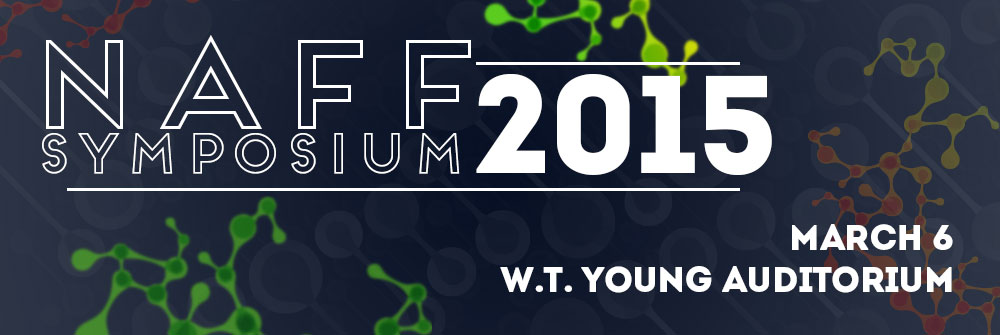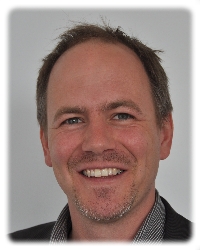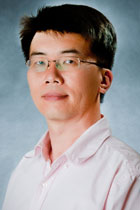
Due to UK's cancellation today, the W.T. Young Library is not open.
All of the Naff events will be held in the Chemistry-Physics Building. The new schedule is as follows:
1:00pm - Philip Tinnefeld
2:00pm - Taekjip Ha
3:00pm - Poster Session & Refreshments
4:00pm - Carlos Bustamante
Single Molecule Approaches to Deciphering Molecular Interactions in Biology
The Department of Chemistry at the University of Kentucky organizes an annual Symposium on Chemistry and Molecular Biology. This Symposium was established in honor of Anna S. Naff, a University of Kentucky graduate, through the generous support of Dr. Benton Naff of NIH. The Symposium has an interdisciplinary character and is attended by students and faculty from Chemistry, Biochemistry, Biology, Pharmacy, Engineering, Agriculture and Medicine. The Symposium features renowned experts from around the world, including Nobel prize-winning scientists and is attended by faculty and students from colleges and universities in Kentucky and the contiguous States.
The Symposium will be held in the William T. Young Library on the University of Kentucky campus. A poster session will be held in conjunction with the Symposium.
Schedule of Events - March 6, 2015 |
|
|---|---|
| 8:00 a.m. |
Registration & Continental Breakfast Gallery, W.T. Young Library |
| 8:45 a.m. |
Welcome Dr. Eli Capilouto, University of Kentucky President Auditorium, W.T. Young Library |
| 9:00 a.m. |
Dr. Philip Tinnefeld DNA Origami Nanophotonics: from Superresolution to Functional Devices Auditorium, W.T. Young Library |
| 10:00 a.m. | Break (refreshments available) |
| 10:30 a.m. |
Dr. Taekjip Ha Genome Maintenance Up Close and Personal: Eavesdropping on Single Molecular Conversations Auditorium, W.T. Young Library |
| 11:30 a.m. | Lunch |
| 1:30 p.m. |
Poster Session - To view the abstracts, click here. Multipurpose Room, B108C, W.T. Young Library |
| 2:30 p.m. |
Dr. Carlos Bustamante
Division of Labor and Coordination Among the Subunits of a Nearly Perfect Biological Machine
Auditorium, W.T. Young Library |
Abstracts & Bios |
|---|
|
DNA Origami Nanophotonics: from Superresolution to Functional Devices Abstract: In recent years, DNA nanotechnology has matured to enable robust production of complex nanostructures and hybrid materials. We have combined DNA nanotechnology with sensitive optical detection to create functional single-molecule devices such as nanoscopic rulers for superresolution microscopy and energy transfer switches. DNA origamis are also used to construct nanoscale force balances with FRET readout or for single-molecule placement in zeromode waveguides using nanoadapters. Especially, self-assembled nanoparticles forming optical antennas can enhance fluorescence and hold great potential for single-molecule detection at higher concentrations for biomolecular assays but also for diagnostic applications. I will discuss recent advancement in fluorescence enhancement and how to disentangle the complex factors that generally influence the fluorescence of single molecules near metallic nanostructures.
His research is inspired by our emerging abilities to study and built matter bottom-up, starting from single molecules. He has contributed to the breakthroughs of single-molecule superresolution microscopy by discovering the switchability of commercially available fluorescent dyes such as Cy5 and by discovering the reducing and oxidizing system (ROXS) which nowadays constitutes the photophysical model of antifading formulas for fluorescent dyes. He then was involved in the development of three superresolution techniques including dSTORM, Blink Microscopy and DNA PAINT. In recent innovations, he combined optical single-molecule detection with DNA nanotechnology for self-assembled molecular devices with optical readouts including energy transfer switches, calibration nanorulers, nano-adapters, optical signal amplifiers and molecular force balances. Dr. Tinnefeld has authored more than 110 publications and patents. He received several awards including a Schloessmann Award of the Max-Planck-Society, the Chemistry prize of the Göttingen Academy of Science and is recipient of an ERC starting grant.
|
|
Genome Maintenance Up Close and Personal: Eavesdropping on Single Molecular Conversations Abstract: Single-molecule detection has opened vast avenues to investigate aspects of biological systems that are inaccessible by any other technique. Research in my lab is focused on pushing the limits of single-molecule detection methods to study biological systems with multiple components to better mimic the cellular conditions. In the first part, I will describe the surprising and deep insights, revealed by multi-color FRET and fluorescence-force spectroscopy, on the dynamics of DNA repair proteins on single stranded DNA. In the second part, I will describe a single-molecule pull-down (SiMPull) assay that combines the principles of a conventional pull-down assay with single-molecule fluorescence microscopy and enables direct visualization of individual cellular protein complexes. SiMPull can reveal how many proteins and of which kinds are present in the in vivo complex and is widely applicable to various signalling proteins found in the cytosol, membrane and cellular organelles, and to endogenous protein complexes from animal tissue extracts.
Dr. Ha’s research is focused on pushing the limits of single-molecule detection methods to study complex biological systems. His group develops state-of-the-art biophysical techniques (e.g., multicolor fluorescence, super-resolution imaging, combined force and fluorescence spectroscopy, vesicular encapsulation, single-molecule pull-down) and applies them to study diverse protein–nucleic acid and protein-protein complexes, and mechanical perturbation and response of these systems both in vitro and in vivo. Ha is the author of more than 180 papers and has received numerous awards including Outstanding Young Researcher Award, AKPA; Research Innovation Award, Research Corporation; Searle Scholars Award; NSF CAREER Award; Fluorescence Young Investigator Award, Biophysical Society; Cottrell Scholar, Research Corporation; Beckman Fellow at Center for Advanced Studies, University of Illinois; Xerox Faculty Research Award, University of Illinois; Alfred P. Sloan Fellow; Beckman Fellow, Center for Advanced Study (CAS); Howard Hughes Medical Institute Investigator; Fellow, American Physical Society; Michael and Kate Bárány Award for Young Investigators, Biophysical Society; University Scholar, University of Illinois; Ho-Am Prize in Science, Ho-Am Foundation, Korea. |
|
Division of Labor and Coordination Among the Subunits of a Nearly Perfect Biological Machine
Dr. Carlos Bustamante, Raymond & Beverly Sackler Chair of Biophysics, University of California, Berkeley Abstract: As part of their infection cycle, many viruses must package their newly replicated genomes inside a protein capsid. Bacteriophage phi29 packages its 6.6 mm long double-stranded DNA using a pentameric ring nano motor that belongs to the ASCE (Additional Strand, Conserved E) superfamily of ATPases. A number of fundamental questions remain as to the coordination of the various subunits in these multimeric rings. The portal motor in bacteriophage phi29 is ideal to investigate these questions and is a remarkable machine that must overcome entropic, electrostatic, and DNA bending energies to package its genome to near-crystalline density inside the capsid. Using optical tweezers, we find that this motor can work against loads of up to ~55 picoNewtons on average, making it one of the strongest molecular motors ever reported. We establish the force-velocity relationship of the motor. Interestingly, the packaging rate decreases as the prohead fills, indicating that an internal pressure builds up due to DNA compression attaining the value of ~6 MegaPascals at the end of the packaging. This pressure, we show, is used as part of the mechanism of DNA injection in the next infection cycle. We have used high-resolution optical tweezers to characterize the steps and intersubunit coordination of the pentameric ring ATPase responsible for DNA packaging in bacteriophage Phi29. By using non-hydrolyzable ATP analogs and stabilizers of the ADP bound to the motor, we establish where DNA binding, hydrolysis, and phosphate and ADP release occur relative to translocation. We show that while only 4 of the subunits translocate DNA, all 5 bind and hydrolyze ATP, suggesting that the fifth subunit fulfills a regulatory function. Finally, we show that the motor not only can generate force but also torque. We characterize the role played by the special subunit in this process and identify this the symmetry-breaking mechanism. These results represent the most complete studies done to date on these widely distribute class of ring nano motors.
Dr. Bustamante is a professor of molecular cell biology, physics, and chemistry at the University of California, Berkeley where he also serves as the Raymond & Beverley Sackler Chair of Biophysics. He is also biophysicist faculty scientist at Lawrence Berkeley National Laboratory. Dr. Bustamante is the author of more than 250 publications. He is a member of the National Academy of Science and was also elected as a Member of the Chilean Academy of Science. His accolades include the Searle Scholar award, Alfred P. Sloan Fellowship, the Raymond and Beverly Sackler International Prize in Biophysics, the Vilcek Prize, National Science Prize of Peru, Hans Neurath Prize of the Protein Society, and the Southern Peru Copper Corporation Prize. He has been recognized as an Honorary Professor and Doctor Honoris Causa by the Universidad Nacional Mayor de San Marcos in Lima, Peru; Doctor Honoris Causa by the Universidad Nacional de Ingenieria in Lima, Peru; Doctor Honoris Causa by the Universidad Peruana Cayetano in Heredia, Peru; Honorary Member of the Spanish Biophysical Society; and Doctor Honoris Causa from the Universidad Peruana Ricardo Palma in Lima, Peru. |
2015 Naff Committee Members:
Professor Chris Richards (Chemistry, Committee Chair)
Professor Jason DeRouchey (Chemistry)
Professor Marcelo Guzman (Chemistry)
Professor Anne-Francis Miller (Chemistry)
For more information, contact Dr. Chris Richards.

 Bio:
Bio:  Bio:
Bio:  Bio:
Bio: